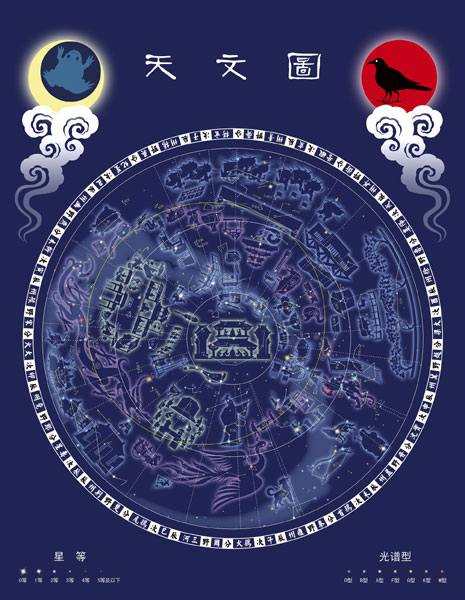Starry, starry night
Updated: 2015-01-07 08:04
By Xing Yi(China Daily)
|
|||||||||||
 |
|
Inscriptions on a stone stele from the Song Dynasty. [Photo provided to China Daily] |
Those constellations are further grouped into three Yuan (Enclosures), which are three round areas around the North Celestial Pole that can be seen year-round in the Northern Hemisphere, and 28 Xiu (Mansions or lunar lodges), which are similar to the zodiacal band but are divided according to the movement of the moon over a lunar month instead of the sun in the course of a year.
Each constellation has its name and meaning. For example, Zi Wei Yuan (the Purple Forbidden Enclosure) reflects the Forbidden City where emperors and their families lived. Some of the constellations in it are named Emperor of Heaven, Crown Prince and Guardian. Tai Wei Yuan stands for the Supreme Palace, where the constellations are named after officials and ministers.
In the Tian Shi Yuan (Heavenly Market Enclosure), the constellations are named after the tools, facilities and people in the market, such as Textile Ruler, Jewel Market and Officials of the Market.
Unlike Western constellations where the stars in one constellation often resemble a shape, Chinese traditional constellations are largely simple dots and lines, and many constellations have only one or two stars.
The book introduces all the Chinese constellations with Bu Tian Ge (Ballad of Sky Walking), which was compiled around AD 600, in a long verse containing the names, locations and features of those constellations.
The book came about through an accidental discovery in 2009, when Qi was cleaning old Chinese astronomical instruments in Beijing Ancient Observatory with Wan.
They found there were many differences between the constellations on the instruments and the astronomy chart inscribed on the stone stele from the Song Dynasty, which was found in Suzhou, East China's Jiangsu province, and believed to be the oldest stone stele of its kind.
The discovery led Qi and Wan to study the differences.
Related Stories
Book tells story through ALS patient's eyes 2014-12-31 06:53
Retired state leader publishes book on reform efforts 2014-12-23 17:59
Author records big year for book sales 2014-12-23 07:52
New book on victims of Japanese invasion in NE China 2014-12-18 16:53
Wudang publishes photo book 2014-12-17 10:33
Today's Top News
Export quota system for rare earths abolished
Euro slumps amid concern over Greek exit after election
New York City community rallies around Liu family
Stock link bid for HK, Shenzhen
The 2015 Palace Museum datebook goes viral
China braces for slower but better growth in 2015
8 missing after cargo ship capsizes off Scotland
PLA announces a major reshuffling
Hot Topics
Lunar probe , China growth forecasts, Emission rules get tougher, China seen through 'colored lens', International board,
Editor's Picks

|

|

|

|

|

|





